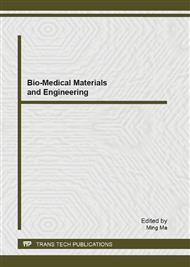p.262
p.270
p.273
p.277
p.283
p.289
p.293
p.299
p.304
Synthesis and Properties of Hybrid Materials for Ion-Exchange and Complexing Membranes
Abstract:
Hybrid materials are attractive for a large range of applications from medicine and biotechnology to telecommunication systems and fuel cells. In the present research we have studied sol-gel synthesis of hybrid composites based on carbofunctional organosilicon monomers N,N-bis-(3-triethoxysilylpropyl) thiocarbamide (I) or 2-{[3-(triethoxysilyl) propyamino} pyridine (II), and copolymers of ethylene glycol vinyl glycidyl ether with vinyl chloride. The polymeric materials were characterized by scanning electron microscope (SEM) and IR-spectroscopy. Gel products possess high thermal stability (decomposition temperatures reach 250 °С) and have developed specific surface (to 20 m2g-1).The synthesized composites comprise semi-interpenetrating polymer networks, consisting of three-dimensional and linear polymers that cannot be separated due to the mechanical interlacing of theirs chains. Hybrid composites have a value of sorption capacity for Pt (IV) ions of 70 (I) and 28 (II) mgg-1. Proton conductivity of membranes based on the synthesized composites is characterized by the values 3.52 10-2 (I) and 1.19 10-2 (II) Scm-1 measured at temperature of 25 °C.
Info:
Periodical:
Pages:
283-288
Citation:
Online since:
August 2013
Keywords:
Price:
Сopyright:
© 2013 Trans Tech Publications Ltd. All Rights Reserved
Share:
Citation:


